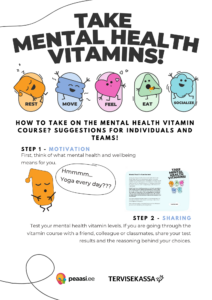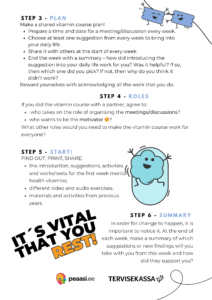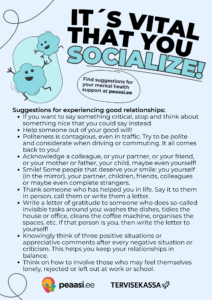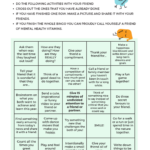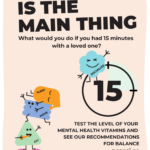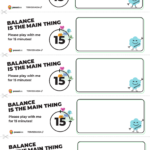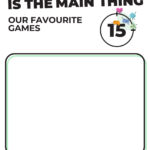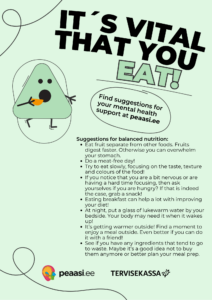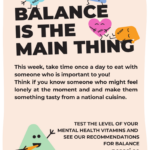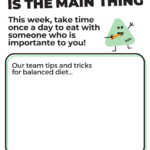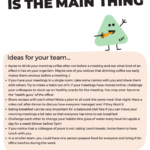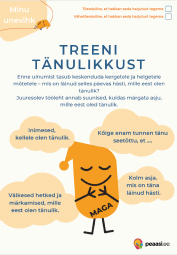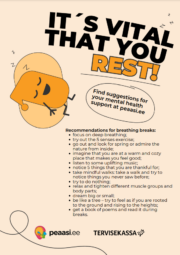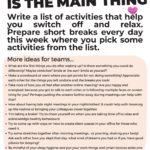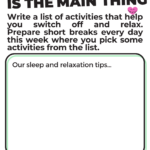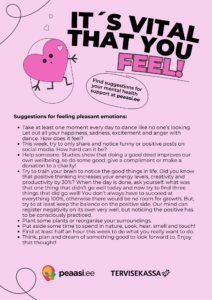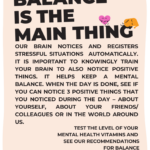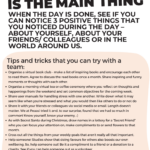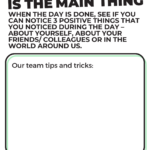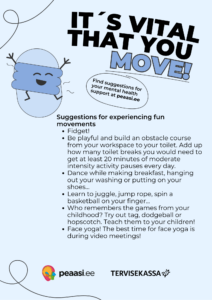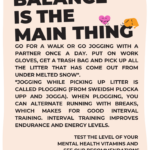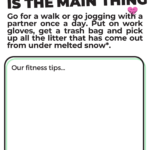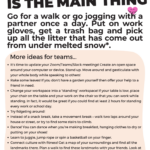Take mental health vitamins and recharge your happiness batteries
You can almost feel spring in the air, but it’s not quite here yet! This is the fourth year of the Peaasi.ee mental health vitamins campaign. We are here to gently remind you what our mental health needs for its wellbeing and what are the actions that you can take to keep your mental health in check and happy. We all have the skills and know-how, but sometimes in our hectic life we need to be reminded of them. This is what the mental health vitamins campaign is for! We ask you to take the vitamin test, take the vitamins themselves and train your brain to notice the positive things in your life so that your happiness battery can be recharged!
This year we have decided to focus on the joys of school, work and life, because that battery always tends to get low before the big summer break… In truth, there is a lot more joy and happiness in our daily life than we realize – we just have to remind ourselves to notice them and to train our brain to regularly FEEL JOY!
The Mental health vitamins treatment course begins!
VITAMIN SLEEP 11-17. March
VITAMIN NUTRITION 18-24. March
VITAMIN PLEASANT EMOTIONS 25-31. March
VITAMIN FITNESS 1-7. April
VITAMIN RELATIONSHIPS 8-14. April
The Peaasi.ee mental health vitamin course consists of five themed weeks that you can try out anytime at your own pace by yourself or with friends, family or colleagues. At the start of each week, we will share specific materials that will have one main suggestion and various supporting activities, life-hacks and info regarding events and actions that are happening that week. Choose at least one suggestion every week to introduce into your daily life so that your mental health can regain its balance and JOY!
How to take on the mental health vitamin course? Suggestions for individuals and teams!
Step 1 - MOTIVATION
First, think of what mental health and wellbeing means for you.
Step 2 - SHARING
Test your mental health vitamin levels. If you are going through the vitamin course with a friend, colleague or classmates, share your test results and the reasoning behind your choices.
Step 3 - PLAN
Make a shared vitamin course plan!
- Prepare a time and date for a meeting/discussion every week (you can align this with your regular team meetings).
- Choose at least one suggestion from every week to bring into your daily life.
- Share it with others at the start of every week.
- End the week with a summary – how did introducing the suggestion into your daily life work for you? Was it helpful? If so, then which one did you pick? If not, then why do you think it didn’t work?
- Reward yourselves with acknowledging all the work that you do.
Step 4 - ROLES
If you did the vitamin course with a partner, agree to:
- who takes on the role of organising the meetings/discussions?
- who wants to be the motivator 🙂 ?
What other roles would you need to make the vitamin course work for everyone?
Step 5 - START!
FIND OUT, PRINT, SHARE
- the introduction, suggestions, activities and worksheets for the first week mental health vitamins;
- different video and audio exercises;
- materials and activities from previous years.
Step 6 - SUMMARY
In order for change to happen, it is important to notice it. At the end of each week, make a summary of which suggestions or new findings will you take with you from this week and how did they support you?
If you wish, you can download the specifically designed: Mental health vitamin course guide
CLICK ON THE MENTAL HEALTH VITAMINS BELOW TO READ MORE ABOUT WHAT YOU CAN DO FOR YOUR MENTAL HEALTH EACH WEEK!
Communication is a daily part of our lives at schools, home, on the streets, in the shop, at the park or on the hiking trail. Face to face, on the phone, as text messages, on the computer. With words, smiles, expressions, body language.
Healthy relationships are a basic necessity for humans. That’s why we feel so bad when we are lonely and have no one to share our thoughts with. But how to maintain healthy relationships? There are many tricks and techniques to learn and follow.
SUGGESTION for the week of RELATIONSHIPS: map your social network and find 15 minutes each day to try one of the activities below.
Who is in my social network and who am I there for? You may have a close friend, a partner or maybe even a neighbour or an acquaintance. Why not a nice shopkeeper or a friendly face at the cafe that you see often? A pet can be a good listener or you yourself can be a good partner to go to the movies with. A relationship with nature is something that may help you be yourself.
Read and think:
Who helps you with work tasks or homework?
Who offers you emotional support?
Who thinks along with you?
Who listens to you?
Who can be trusted with a secret?
Who dares tell me honest truths or give me constructive criticism?
Who helps me form an adequate or full picture of a situation?
Who empowers me and is always on my side?
Who do I celebrate with?
Who do I laugh with?
Who do I play or fool around with?
Who do I enjoy pleasant activities with?
Who do I take to events?
Who helps me with practical tasks when I need it?
Who can lend me sugar or batteries?
Who helps me with IT related questions or helps me fill my tax return forms?
Who gives me good book, film, music or TV show recommendations?
Pick the three most important questions, find answers for them and then write them down on a small sheet of paper to keep in your wallet or on your phone to carry these truths around with you.
TAKE A LOOK AT THE PREVIOUS MENTAL HEALTH VITAMIN COURSE MATERIALS
- Tips for maintaining good relationships that you can try yourself:
- Every day this week, set aside 15 minutes for playing, messing about, joking around or chatting with someone close to you. Give a friend the gift of 15 minutes of your undivided attention for spending time together.
- If you want to criticise something, stop and think if you can say something nice about it instead.
- Organise a small party through a video call! For example: did you buy yourself a new frying pan? Celebrate it by cooking your favourite dish and then surprise your friends with a packed meal in front of their doorstep. You can later enjoy and discuss the meal together through a video call.
- Just go and help someone… of your own accord.
- Compliment a colleague… and your flatmate… and your friend… your parents, children, yourself!
- Try to set aside 20 minutes to listen to and support someone else.
- Hide a treat in your friend’s pocket or leave it at their doorstep… into their mailbox? It doesn’t matter where as long as it’s a pleasant surprise for them!
- Does your friend always forget or lose their pen, lunch or phone? Be helpful and remind them of these items or pack the items for them yourself.
- Smile! Here’s an idea of those who can definitely benefit from your smile: you yourself, your partner or flatmate, children, friends, colleagues and even complete strangers.
- Be grateful for or thank someone who has helped you in the past. Tell it to them face to face, by telephone or write it to them as a letter.
- Send or leave a letter of gratitude to someone who is doing “invisible” tasks: washing the dishes, cleaning, tidying up the bookshelf, washing the coffee machine, etc. If that is you then write the letter to yourself.
- Have a 10 minute conversation with someone who you don’t usually talk to.
- Knowingly start three positive conversations or remarks for every stressful conversation or critical remark that you receive or take part in. This helps you keep your relationships in a healthy balance.
- Tips for maintaining good relationships that you can try with your team:
- Start a meeting by acknowledging the work that each of you has done.
- Write short instructions to each other on the topic of “if you notice that I am in stress then I wish that you would support me by saying or doing …”. Share these instructions with each other, be curious about individual differences and try to come to an agreement.
- On Fridays, find out how others are planning to unwind and relax in the weekend. This allows the team to inspire each other and discuss if their plans came true on following Mondays.
- Start a meeting with a round of sharing how each one of you is currently feeling in humorous ways (find a funny scale online, use emotes or body language, etc). Agree to accept different feelings and support each other.
- Find an agreement on how everyone can support their mental health, unwind their stress levels and take time out for their families at the workplace.
- Find ways of giving each other more positive feedback.
- Find ways of encouraging communication with your teammates, even when working from a distance:
- For example, drink coffee together during a morning video call and discuss non-work-related subjects.
- Have your lunch together over a video call or take a walk together while talking over the phone.
- Think of how to include those who may feel lonely, left out or excluded at the workplace.
- Share articles and tips (that build relationships) on subjects that are interesting to all of you through internal communications.
- Perform a survey of satisfaction at your workplace and look at the results. Try to think of what can be improved with ease and see if you can achieve these goals without much time and effort?
- Challenge your team members to each donate at least 1 Euro to a charity of their choice and discuss why you chose the way you did. This way you can be charitable together and learn to know each other more!
- Don’t overstress with supporting relationships – sometimes even small conversations or good words help your colleagues feel that they are appreciated.
Supporting relationships help us keep our lives in balance. Balance is the main thing!
- Discuss together how to maintain a good relationship supports our mental balance?
- Give students more homework than usual that can be done in groups or pairs to provide additional opportunities for communication and collaboration.
- Hand out CONVERSATION CARDS at the beginning of the week (you can download and print them out or share online), divide students into pairs and let them talk about good relationships with conversation cards. Discuss together at the end of the week how it went and what they noticed).
- Encourage students to talk for at least 10 minutes with someone they do not usually talk to a lot. Let them share their observations: Was the task easy for them? Difficult? What did it teach them?
- GAME IDEA – NEW CHOICE:
- Carry out a joint brainstorm and write down the different communication situations that children and
young people this week have had. Eg gratitude, sharing, support, but also
insult, quarrel, anger. - Form pairs and let each pair choose one of the situations. Now let them write it out as a dialog (what happened, what someone said and how they behaved). As a twist they have to make a NEW CHOICE, meaning they have to come up with at least 3 different endings to this situation. You can make it as writing task, but it can also be as a creative video task. Afterwards have a discussion round: what were the pro’s and con’s of each ending.
- The purpose of the exercise is to experience through play that in a communication situation we have
the opportunity at any moment to choose how we react – whether we get irritated or we try to stay calm. Choices can be made at any moment of communication and it is good if we can do them consciously.
- Carry out a joint brainstorm and write down the different communication situations that children and
INSPIRATION TALKS ON GOOD RELATIONSHIPS
| HOW TO SUPPORT YOUR MENTAL HEALTH WITH A BALANCED DIET?
Mental health benefits most from a regular and varied diet, where you consider what you eat and pick foods that are good for your body and mind. It’s not only important to take note of what you eat, but also when you eat.
SUGGESTION for the week of nutrition: Mindful eating
Which positive emotions could come from following this tip? Set aside one meal each day to enjoy with all of your senses. Think about who made this food, where are the ingredients from, how many people have contributed in bringing it to your table and how? What does it look like? What colour and shape is it? Close your eyes and smell it: what connections does that smell form with your thoughts or feelings? Touch the food: what does it feel like between your fingers or in your mouth? Is it soft, hard, crisp? What sound does it make when you chew on it? Focus on the taste: what nuances can you notice? Is it sweet, salty, sour or bitter? Now try to notice the pleasant emotions that you can feel. If you are doing the challenge with someone else, compare your experiences. Mindful eating can improve your relationship with food, your mental wellbeing, your enjoyment of food and gratefulness (Khan & Zadeh, 2014).
|

Suggestions for balanced nutrition:
- Eat with others! A study by Dunbar (2017) states that eating together corresponds with a feeling of closeness between people and with general wellbeing.
- Headspace “Mindful eating”
- Inspiring talk on balanced nutrition – TED TALK
TAKE A LOOK AT THE PREVIOUS MENTAL HEALTH VITAMIN COURSE MATERIALS
Tips and tricks that you can try yourself:
- Before going to bed at night, take a glass of lukewarm water with you. Your body needs it in the morning!
- Eat fruit separately from other foods. Fruits digest faster in the stomach and eating them together with other foods can cause digestion issues.
- It’s getting warmer outside! Find a moment to enjoy your lunch outside. It would be great if you could enjoy it together with a friend, even over a video call!
- Before starting a meal, take a moment to smell the food and enjoy the good smells.
- Look for foodstuffs that are about to go bad in your cupboards. Consider not buying them anymore and try to plan your meals ahead.
- Have a meat-free day!
- Listen to your body after eating. Your body is actually very good at giving signals about what it likes and doesn’t like.
- Drink a glass of water every time you want to snack on something. Maybe your body is thirsty instead!
- Keep a food diary! Yes, it is annoying to start and keep up, but try to do it for at least 3 days. You will learn to notice your eating habits and maybe this would be a good method for improving these habits.
- When possible, try to eat slowly and focus on the taste, texture and colours of the food!
- Listen to your body when it craves for something! Sometimes the body is asking for a certain type of food, sometimes it’s thirsty instead, but sometimes it’s tired, bored or there’s another unfulfilled emotional need behind the craving!
- If you tend to skip meals because you are in a hurry, try to plan your meals one day or maybe even a week ahead. This way you don’t have to think about what or when to eat when you have a tight schedule.
- If you notice that you are a bit nervous or have trouble with concentrating then ask yourself if you are hungry? If so, then try to snack on something.
Tips and tricks that you can try with a team:
- Agree to drink your morning coffee after not before a meeting and see what kind of an effect it has on your organism. Maybe one of you notices that drinking coffee too early makes them anxious before a meeting 😉
- If you have your meetings in a single room, take some carrots with you and share them with others. Try to make a habit out of it. If your meetings have moved online, challenge your colleagues to stock up on healthy snacks for the meeting. You may even become the “health guru” of the office!
- Share recipes with each other! Make a plan to all cook the same meal that night. Have a video call after dinner to discuss how everyone managed and if they liked it.
- Eating breakfast can be very important for a balanced diet! See if you can move your morning meetings a bit later so that everyone has time to eat breakfast!
- Challenge each other to change your habits! One glass of water every hour! An apple a day for a week! Dinner before 7pm!
- If you notice that a colleague of yours is not taking lunch breaks, invite them to have lunch with you.
- In a smaller team, you could have one person prepare food for everyone and bring it for office lunches during the week.
- Tips and tricks for teachers who want to teach their children about balanced nutrition:
- Ask your students to bring their favourite vegetable or fruit that they like to snack on to class. You can discuss what vitamins or health benefits these foods have on you together.
- Let your students have an inner dialogue with their Feelings and Body. For example, Feelings want to reach out for junk food, but how does your Body react to that? Perhaps they could perform a small play where the dialogue is interrupted by the voice of Reason?
- At the start of a week hand out CONVERSATION CARDS in your class (you can download and share them online individually or print and cut them out), divide your students in pairs and let them discuss the conversation cards with each other. At the end of the week, discuss how the assignment went and what they noticed.
- Have a snack break during a video call! You can leave the screes on 😉
- Fridge BINGO (if you are learning from distance, you can do this over a shared video call; if you are at school, leave some of the tasks as homework):
- draw a BINGO card and brainstorm different foods to write in the boxes.
- go and see if you can fill a BINGO line with the foods in your fridge?
- choose your favourite foods and prepare a healthy snack with them.
- Share your recipes and thoughts
- Do a healthy eating exercise in class: investigate foods with different senses: touch, sight, smells with eyes closed, tasting small bites. See if food seems different when eaten slowly and with focus!
- Homework idea: organise a shared balanced menu and try to have the family prepare the meals together. Discuss your experiences in class!
INSPIRING TALKS ON BALANCED NUTRITION
HOW TO SUPPORT YOUR MENTAL HEALTH WITH REST?
Resting is as important and unavoidable for us as breathing, drinking water and eating, as during rest, our vital bodily functions regenerate. This is why we feel unwell when our sleep is interrupted. This doesn’t mean that the small moments of rest during the day are any less important. How to find time for sleeping and moments of rest during the day? There are various skills that can be learned and principles to be followed.
SUGGESTION for the week of rest: Take a breathing brake 3 times a day (daily suggested dose: 3×3 min)
Which positive emotion could following this suggestion create?
The goal of breathing is to support the momentary vital functions of your body. This means that the way that we breathe (speed, depth, frequency) corresponds to our current activity, emotional state or thoughts. So, if you breathe a certain way, you can support your body in that specific way. By taking a breather to calm our breathing and take deeper breaths, we can force our body and thoughts to also calm down. A calm consciousness has the ability to have a wider grasp of our attention, which also helps us notice all the beauty around us. It also forms the basis for reminding ourselves of the aspects of our life that we are thankful for. A calm mind has an easier time at being “aware” and also helps us feel relaxed as a bonus.
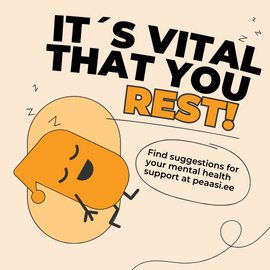
TAKE A LOOK AT THE PREVIOUS MENTAL HEALTH VITAMIN COURSE MATERIALS
- Every day, knowingly set aside time for sleep. You can even write your planned bedtime in the calendar so that you can get enough hours of sleep by the next morning. Turn off all screens at least an hour before sleep and do something relaxing instead.
- Set aside at least 5 minutes every day to daydream about being on holiday. Proper holiday! Close your eyes and listen to relaxing music, birdsong or the sound of the waves from your headphones and imagine how you would feel during this holiday.
- If your worried thoughts keep disturbing your sleep and moments of rest, set aside about 20–30 minutes during the day for worrying and then do relaxation exercises to help you come to terms with these thoughts.
- Learn mindfulness and relaxation techniques. Even counting sheep can help you distract yourself from your worries.
- If worried thoughts keep you awake at night, get up and do something relaxing for a bit and then try to fall asleep again.
- To improve sleep, put your smart devices aside, step away from work and focus on something that relaxes and calms you down before bedtime – listen to good music, spend time with your pet, talk face to face with a family member or take a small walk outside.
- Be more physically active – at least 150 minutes per week. You could try walking to work or taking a small walk during your lunch break.
- Try to spend more time in the nature.
- Instead of using apps and devices to track your sleep and wellbeing, try to trust your intuition instead. This can alleviate some of your sleep related worries.
- Take a breather from your everyday thoughts and go play instead. Who said that only children can play games? Play with your partner or family members, tickle or try to make them laugh. This can distract you from everything else! When alone, you can make funny faces in front of the mirror until you can’t hold back your laughter. As long as you’re having fun!
- Set an alarm or reminder for yourself of when to go to sleep and when to wake up. This helps your body to follow a necessary sleep routine.
- Read before sleep. This can make you fall asleep more easily or maybe even too easily!
- Do you have a good pillow? If you toss and turn in bed at night, maybe it’s because your pillow is uncomfortable or old. If so, it would be a good time to pamper yourself with a new and comfortable pillow!
- Some radio stations have bedtime stories that can also help adults fall asleep! You can search for bedtime stories to listen to online.
- If you have trouble falling asleep alone then see if you can call a friend and fall asleep together!
- Mindfulness exercises before sleep help you rid yourself of daytime stress and calm your thoughts. Look for mindfulness exercises online!
- Take a shower before sleep and try to mentally clean yourself from everything that caused you stress during the day. This allows you to go to bed more relaxed.
- Learn from our European neighbours! A small siesta fits our current state of emergency very well! Take a moment to rest during the day and try to get your whole family involved. All your daily commitments can wait at least 5 minutes!
- If you sleep enough during the weekdays then you won’t have to fix your “sleep debt” during the weekend and can use the extra time to work on your mental health in other ways instead.
- New-born babies require set sleep patterns, but what about your needs?
- Listen to silence! Where is the most silent place in your life?
- Try the Pomodoro technique – the goal is to work without interruptions for 25 minutes and then take a 5-minute break to stretch your legs or drink water. if you finish work before the “tomato time” then spend the rest of the 25 minutes on analysing and thinking about your completed work.
- We all have 168 hours in a week. If we sleep 8 hours per day and work 40 hours per week then we have 72 hours left over for other things. What do you do with that time?
- Take a piece of paper and draw 2 pie charts on it. One of them is your ideal daily activity pie chart (how many hours you spend on sleep, rest, work and hobbies) and the other is your real activity pie chart. Compare the two. See if there is anything you can do to make your reality chart more like your ideal chart?
- What are your early morning routines when you wake up? Is there something you could do differently? Stretches? Smile at the sun? Smile at yourself? Think about last night’s dreams?
- Do you like to press the snooze button on your alarm clock? Maybe it’s a sign of your body asking for a different sleep pattern? Is there something you can do about that right away?
- Do you sometimes think that relaxing and resting has to be earned with hard work? Try to let go of this belief for at least a week. Resting is a basic necessity no matter what you do with your time.
- Take a small 30-minute nap during the day.
- Take a moment to think about what resting and relaxation means for you?
- Keep a calm head and focus on the following:
- While sitting at a table, breathe in and raise your shoulders to your ears.
- Let your shoulders fall during exhaling so that tension is relieved.
- Look up and raise your arms one by one as if you’re trying to catch the sky.
- Rub your head enthusiastically and tap all over it with your fingertips. Grab yourself lightly from your hair and let your hands go.
- First pinch your jawbone area and then tap it with your fingertips. Then yawn loudly!
- Challenge your team to a small competition next week like a photo or video competition on how to take care of your mental health when working from home.
- Organise a regular chat with your teammates where you share things that are not work related (share your worries and joys, your difficulties and tips on how to surpass them, think about what you would do best if you were a member of the government, etc).
- The Estonian Vikerraadio radio station has a work out programme every workday at 11:05 that you could perform with your team. If you don’t speak Estonian, try to find a similar programme online.
- Make a leaderboard for people at work who didn’t do something! Acknowledge each other for being lazy and taking breaks every now and then!
- Take note of how you all feel after video meetings. Are you happy and lively because you could speak to other people or is seeing all the faces on the screen tiring for you? Maybe you would benefit from moving the screens farther away during meetings and focus on listening to them instead? If you use Zoom then you can turn off your video to make it more natural.
- Charge your phone battery, find working headphones with a built-in microphone and a weather-proof workstation and pencil. Take all of these things outside and organise at least one “walking meeting” next week.
- If you are working from home, create small rituals for yourself so that you can better transition yourself to work and later back to domestic life again. This could be a walk, calling to a friend, listening to music, meditating, working out
or a small coffee or tea break. - Try having meetings at night and in bedclothes. This could help you switch things up and get to know your colleagues better.
- Our dreams are often like movies. Challenge your team to write down the most exciting dream plots and to arrange them into short stories.
- Let every student write down their sleep routine – what are they doing to improve their sleep at night?
- Choose the sleep and resting masters of your class. Best at counting sheep! Master sleeper! Champion of relaxing!
- Create a list of words that describe laziness: hanging out, lazing about, having a lie down, chilling, relaxing, loitering, etc. See how many more words you can think of!
- Give your students at least one homework exercise per day where they have to go outside. Examples: Go and measure the length of spring flowers outside. Who has the largest puddle by their house? Or a patch of grass instead? Find the most silent place in your life and go listen to the silence!
- Inspire your students to become the ambassadors of rest at home:
- Let them write down 3–5 different ways to relax near their homes (like looking for signs of spring or going for a hike in a park)
- Now let them take a photo of every place or method they wrote down and describe them with a couple of sentences.
- When that’s done, tell them to craft small “rest ambassador flyers” where they describe why rest is necessary and bring out 3–5 examples of taking time out near your homes.
- The sleep police game:
- Browse our materials on vitamin sleep.
- Let each student write down the rules of sleep of their home.
- Challenge your students to become the sleep police of their house, who:
- set bedtimes in their households in a way that all children get at least 10 and all adults at least 8 hours of sleep;
- remind family members to put down smart devices an hour before bedtime;
- reward the best sleepers of their household with small prizes.
- Introduce the Pomodoro technique to your students. This technique helps them to focus better. Do a task for 25 minutes without interruptions (you can use a timer or app like https://tomato-timer.com/), then take a short 5 minute break where you get up, stretch, drink water or do some other relaxing thing and then focus on work for another 25 minutes. After 4 rounds, take a longer, 60-minute break.
- Organise a sound hunt for your students:
- Brainstorm a list of all the possible sounds that you think you could hear in the next 5 minutes;
- Set a 5-minute alarm;
- Now close your eyes and focus on the sounds around you;
- After the alarm, make checkmarks after every sound in the list that you heard and improve the list with all the sounds you heard but could not think of before.
Conversation cards: Sleep and rest vitamins
Download the files:
INSPIRATIONAL VIDEOS ON SLEEP-VITAMIN
EXPERIENCING PLEASANT EMOTIONS
Emotions are an inseparable part of our daily lives. It would be difficult to imagine living without any emotions at all. We wouldn’t feel happiness for receiving an expected gift for our birthdays, we wouldn’t feel sadness for the loss of a close one, we wouldn’t feel disappointment for the cancellation of an expected trip, nor would we feel shame for being caught doing something inappropriate. Not to mention the surprise we’d feel when a good friend unexpectedly appeared at our doorstep.
You could say that it’s largely the emotions that give our days their unique and memorable flavour. It’s undoubtedly best for our mental health to allow ourselves to feel and experience different emotions. However, sometimes it’s good to try and knowingly focus on experiencing more pleasant emotions to keep your mental health in balance. Pleasant emotions are the following: happiness, gratitude, sincerity, interest, hope, amusement, inspiration, admiration, love, surprise, peace.
SUGGESTION for the week of PLEASANT EMOTIONS: Three good things
Take 5-10 minutes every day to write down three things that went well that day. Be as detailed as you can and add why you think these things happened. Try sharing these things with your family, friends, classmates or colleagues.
Which pleasant emotions could following this suggestion bring forth?
Martin Seligman, the director of the Positive Psychology Center, found that the people of the study who followed the exercises for just one week were much happier than those who did not and that happiness level stayed high for the six following months (2005).

Recommendations for feeling Pleasant Emotions:
- On Saturday, March 30th, our Mental Health Cafes will open in Tallinn, Tartu, Viljandi, Pärnu and Kuressaare. There, our volunteers, who have completed mental health first aid training, await you to come and speak about your or someone else’s mental health challenges! Sometimes you just need someone to listen to you! Check our website, whether the volunteers in your city can speak English.
- We invite everyone to notice the positive around them on the 28th of March. Notice the positive in others, the weather, the news, the government, the unpleasant tasks or in other places where your thought immediately turns to the negative.
- Inspirational talks on pleasant emotions
– The new era of positive psychology, Martin Seligman
– The habits of happiness, Matthieu Ricard
– The psychology of time, Philip Zimbardo
TAKE A LOOK AT THE PREVIOUS MENTAL HEALTH VITAMIN COURSE MATERIALS
- Start your day with something fun: read the comics in a newspaper first or watch some funny videos on Youtube. Did you know that it has been scientifically proven that humour decreases stress, increases psychological wellbeing, and helps cope with stressful events? Truly, laughing is healthy!
- This week, try to only share or look for funny or wholesome posts in social media. How hard can it be?
- Change up your morning routine! Do you usually eat your breakfast in a hurry? Try eating breakfast at another location instead. Maybe at the terrace? On the living room carpet? In the kitchen, but while you’re dancing at the same time? In front of the house accompanied by birdsong?
- Every day, try to take at least one moment for yourself to just dance like nobody’s looking. Let out all of your happiness, sadness, excitement or anger with dance. How does it make you feel?
- Find something new to learn this week from Youtube. How about dancing, drawing or yodelling?
- Help someone! Studies show that doing favours for others also boosts our own wellbeing. So, help someone out! Be it a compliment to a friend or a donation to a charity. See if you can help someone out as a volunteer for Vabatahtlikud. Or maybe see if you can help out with scientific research at your local university.
- Organise a nice spa night at home. If you’ve run out of body scrub, rub yourself with a coffee and honey mix – it’s very nice and refreshing! Maybe you could prepare a foot bath instead.
- Try to train your mind to notice positive things. Did you know that positive thinking increases your energy levels, creativity, and productivity by up to 30%? When the day is done, ask yourself: what was that one thing that you did not manage to accomplish today and then find at least three things that you did manage to accomplish! Not everything always has to work out 100%. If it did, then there wouldn’t be any room for improvement! Try to keep the scale on the positive side though. Our mind registers things negatively on its own just fine. Positive thinking is something that needs to be practiced consciously.
- Meditate or practice mindfulness. Set aside 10 minutes every day to just sit in silence and focus on the moment: your breathing, the smells around you, your posture, thoughts, feelings.
- Do gratitude exercises: every day, write down 3 moments, things or thoughts that you feel grateful for. Express gratitude towards someone whose existence you’ve taken for granted. Write a sincere thank you letter to them. Think about what you’ve gained from things that didn’t go your way.
- Watch a good film, read a book or craft something – whatever satisfies you.
- Plant some plants, tidy up or organise your surroundings.
- Pamper yourself and your close ones with good food, love or care.
- Set aside some time to spend in nature – see, listen, smell and touch your surroundings.
- Spend some leftover money! Specifically, spend it on a gift for your close ones or colleagues. Buy something and donate it to a charity. See how spending money on someone else makes you feel.
- Find three things that were meaningful today. Washing hands can help protect others; filling in boring tables can be useful for your colleagues by helping them organise their work better; caressing your child is important to spread more kindness in the world. Think about all the things in your daily life that are meaningful for others.
- Find at least half an hour this week to do something that you really want to do.
- Think if there’s already something that you do that makes you feel like you’re in the zone or in the flow. This should be something that you are good at, but can still improve on. Something that makes you lose all sense of time and doesn’t feel like a chore. Something that just flows out of you. Be it some exercise or practice, some mundane task at work, a game or a hobby. If you don’t have such a thing, then try to think of an already existing skill or activity of yours that could be improved into a flow state
- Organise a virtual book club – make a list of inspiring books and encourage each other to read them. Agree to discuss the read books once a month. Share inspiring and funny moments or thoughts with each other.
- Organise a morning virtual tea or coffee ceremony where you reflect on thoughts and happenings from the weekend and set common objectives for the coming week.
- Play blind origami:
- form pairs;
- the host sends one person from every pair an email with an origami instruction;
- agree on a time for the game;
- The partner who received the origami instruction must now guide the other on how to fold the origami (if you are speaking through a video call, turn off video during the folding);
- when you have finished folding, turn on video and share your results;
- you may now join the team chat for general impressions or switch roles.
- Share user manuals for handling stress with one another. Write down what it may seem like when you’re stressed and what you would then like others to do or not do. Share it with your friends or colleagues via social media or email. Length doesn’t matter. We at Peaasi tried it and, to our surprise, found that we had so much in common! Know yourself, know your enemy. 🙂
- Organise a brainstorming session on what the people in your team would like to know or find out about more. Then find ways to acquire that knowledge. Maybe someone knows someone who knows someone that specialises in just that field and is a good instructor? Maybe someone has a lot of experience and would like to share their thoughts and experiences with the team through a webinar? Maybe you stumble upon an exciting online training course that you would like to take together?
- As with Secret Santa during Christmas, draw names in a lottery for a “Secret Friend” who you can focus your attention on, make compliments to or send flowers to that month.
- Organise a circle of gratitude where each team member tells another team member about something that they did that they are grateful for. This can be done regularly – select an individual team member every Friday who receives letters of gratitude from everyone else that day.
- During meetings, share one aspect of your work that you think is meaningful and important. It doesn’t matter if it’s a small or big thing. What’s important is that you focus your attention on what makes your daily lives meaningful, because that makes us happier!
- Find something from daily news that lightens the mood or makes you laugh and share it with your group.
- Cross out all the things from your weekly goals that aren’t really all that important.
- Inspire your students to notice and ask themselves the following: What activities made me really think about something today? What new approaches or strategies did I try today? What mistakes did I do today that I could learn from in the future? What things proved to be a challenge for me today? This kind of analysis helps the students see that their grades and capabilities aren’t really tied to inherent factors, but their continued effort and persistence instead. Noticing these small learning and development opportunities allows them to feel happiness and success! They may say “Oh, that was difficult for me, but I managed in the end!” or “I had to make an effort and even though it didn’t come out as expected this time, I’ll try to learn from my mistakes the next time!”
- Draw a ladder of courage together:
- write down one new skill that a student would like to learn, or a fear that they would like to overcome;
- write it down on the highest step of the ladder;
- now write down small steps that help you achieve the desired goal. Think of it like learning to ride a bicycle with training wheels.
- Start an adventure diary with your class:
- start out with writing some entries of when your students were brave and tried out something new. Add their drawings or other records of the process that show their learning curve (initial difficulties and eventual successes);
- add details about how fun or exciting it was for them to try that new thing;
- next time, if you want to introduce something new to your students and feel like you’re coming up short because they don’t want or dare to try that new thing, then open up your adventure diary and remember how much fun you had learning the previous thing;
- now let the students make entries to the diary themselves. It can be structured as a group assignment.
- Pleasant emotion bingo #1:
- draw a bingo grid, brainstorm different activities that make the students feel pleasant emotions and then write them in the squares. Examples: singing, dancing, being lazy, walking, playing ball, cycling, listening to music;
- now write a single weekday and time period below each activity in the bingo card for doing exactly that.
- those who finished all diagonals, corners, or the entire grid of pleasant activities the last week, shout BINGO and share their favourite moments with others!
- Pleasant emotion bingo #2:
- draw a bingo grid, brainstorm different pleasant emotions that the students would like to feel and then write them in the squares;
- ask the students to see if they have felt these emotions during the week and if so, mark them down on the bingo card;
- those who finish all diagonals, corners, or the entire grid of pleasant emotions last week, shout BINGO and share their favourite emotions with others!
- Form a list of your students’ favourite feel good books, films, youtubers, funny videos or songs. See if you can find common favourites and discuss how these things lift your mood.
- Brainstorm 100 things that you are grateful with the class.
- Discuss how a lesson or subject is important with your students. What kind of benefits does it have for each individual student, their families, the society or the planet – why is it important?
- Share a funny or cute video with your students during class. Even a couple of minutes of relaxing laughter or pleasant emotions help the students focus better.
Conversation cards: Pleasant emotions vitamin
Download suitable file:
INSPIRATIONAL TALKS ON PLEASANT EMOTIONS
Physical activity is good for both your mental and physical health. Regular moderate physical activity (at least 150 minutes a week or 20 minutes a day) helps maintain a feeling of wellbeing, a friendlier self-image, improves the mood, reduces anxiety and increases concentration. It’s thought that these are triggered by changes in the brain’s blood circulation or changes in the hormonal balance activated by physical activity.
Physical activity opens a door to seeking out new experiences. How does one find time for moving though? Every move counts! There are several tricks to use and principles to follow.
SUGGESTION for the week of FITNESS: 5 minutes of fun physical movements every hour
We invite you to take 5 minutes every hour of every day to move yourself in funny, silly, mindless ways – just as feels good for you. When we do something differently, our mind can also find new ways to look at things.
Which positive emotions could following this suggestion bring forth?
Moving backwards improves your balance, tempo and heart and lung functions (Chang et al 2021). Moving backwards requires you to focus on the activity and therefore also helps you be more mindful.
Recent studies confirm that physical activity improves your learning ability and is extremely important for both mental and physical wellbeing.
The World Health Organization suggests taking a 5 minute physical activity break every hour. It has been found that in order to decrease the chance of depression, at least 150 minutes should be spent on moving every week. Schoolchildren should have at least an hour of physical activity every day.
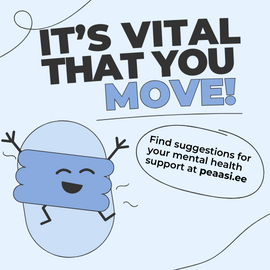
Suggestions for experiencing fun movements:
- WHO “Physical activity” suggestions
- CNN health “The significant health benefits of walking backward”.
- Kangelased “Horisontaalselt”
- 5MIINUST, PUULUUP – “(nendest) narkootikumidest ei tea me (küll) midagi”
- Monty Python’s Ministry of Silly Walks (Full Sketch)
- Meeting walks – charge your phones or smart devices, get earbuds with microphones, grab weatherproof writing implements and organise at least one walking meeting outside at work next week.
TAKE A LOOK AT THE PREVIOUS MENTAL HEALTH VITAMIN COURSE MATERIALS
- Change your workspace into a “standing” workspace! If your table is low, place your chair on the table and your work on the chair so that you can work while standing. Alternatively, you could try using an ironing board as your workspace if the height of the board can be regulated. Doing work while standing every now and then can positively affect your physical fitness as well as your concentration. In fact, it would be great if you could find at least 2 hours for standing every work or school day. You could try doing meetings or phone calls while standing as well!
- Try fidgeting around!
- Instead of a snack break, take a movement break – walk two laps around your house or street, or try to find some stairs to climb.
- Be playful and build an obstacle course from your workspace to your bathroom. Add up how many bathroom breaks a day do you need to get 20 minutes of moderate physical activity done via the obstacle course.
- Don’t overdo it with planning fitness breaks and take it easy. You can start out with placing some items like a dumbbell or jump rope on your workspace that motivate you to take a fitness break. Maybe you’ll grab onto these items the next time you need a break from working.
- Set aside some time for mild exercise. This could be morning stretches, an afternoon online exercise programme, or an hourly reminder or alarm so that you won’t forget to get up and stretch every now and then.
- Once a week, take rubber gloves and a garbage bag with you when going for a walk and pick up any rubbish that you find. If you have children, invite them along with you. This will motivate them not to throw things on the ground. You can use this to also teach them about being careful with picking up used masks, needles or shattered glass.
- Dance! You can dance when you’re making breakfast, hanging clothes to dry or putting on your shoes!
- Before getting up from bed, try to stretch yourself out like a dog or a cat, move your wrists, twist your soles and then get out of bed with the “right” foot!
- It’s time to update your Zoom/Teams/Slack meetings! Create an open space around your computer or device. Stand up. Move around and gesticulate with your whole body while speaking to others!
- Learn to juggle, jump rope or spin a basketball on your finger.
- Those who remember the 80s–90s childhood games like tag, dodgeball or jumping rope can teach them to the next generations.
- Place challenge notes on your fridge. Every time you go looking for a snack, do some squats beforehand!
- If you drive around a lot, see if you can go and do your groceries, lunch break or workday on foot instead.
- Before a meeting at work, agree on a common gesture that you can use at any point during the meeting for a small movement break. Use it actively!
- Charge your phones, get headphones with a built-in microphone and weatherproof stationery and organise at least one meeting a week where you all go for a walk during the meeting.
- Organise a shared fitness club – find some good exercise videos to work out to together or teach each other some playful workout routines instead.
- It’s time to update your Zoom/Teams/Slack meetings! Create an open space around your computers or devices. Stand up. Move around and gesture with your whole body while speaking to others!
- Rake some leaves! If you don’t have a garden yourself then offer your help to a friend in need.
- Face yoga! The best time for face yoga is during video meetings!
- Connect culture with fitness! Since many places are still closed this week then make a plan of all the places you dream of going to when the lockdown is lifted again. Climb up a church’s spire or the TV tower without using an elevator. Visit the entirety of KUMU or the Open Air Museum.
- When possible, give suggestions to the students on how they should do any given exercise. For example, when they need to read something, tell them to try and read it while standing up or walking around the room. When they need to do a written exercise then they can also try and do it on the windowsill or over the ironing board while standing up.
- Take various gestures into use during video lessons that the students can use to show that they are able to follow the subject matter. Examples: a thumbs up to show that they are following along and a thumbs down if they have trouble with something. When they are ready to answer a question, they could stand on one foot or rub their hands together.
- Add “fitness” breaks to your longer video lessons. For example, you could add a slide to your presentation that tells the students to take a 10-minute break, but also challenge them to do a physical exercise of their choice.
- Challenge your students to make a 1- or 2-minute video of a physical exercise programme as homework. Share these videos with each other!
- Plan recesses for both yourself and the children even if you are learning from distance.
- Mimic the movements of different birds and animals together!
- Connect culture with fitness! Since many places are still closed this week then make a plan of all the places you dream of going to when the lockdown is lifted again. Climb up a church’s spire or the TV tower without using an elevator. Visit the entirety of KUMU or the Open Air Museum.
- Open up Youtube, find a good music video and just dance! We recommend searching for Just Dance and find a good track to dance to at school and home.
- Organise a treasure hunt for your students:
- each student makes a treasure hunt game board out of 4×4 squares where each square contains a picture or a description of a thing or its features;
- have the students switch their game boards with each other so that everyone has someone else’s treasure hunt;
- go outside for the treasure hunt and fill your game boards with photos of the found items.
- Organise a pen break for your students:
- Have them take a pen in the right hand, extend their hands and let the pen fall. Now have them try catch the pen before it falls down. Do the same with the left hand.
- Have them lift their leg in front of them and try to throw the pen from under their legs and catch it from the other side. Try the other leg next.
- Find out the master of obstacle courses in your class:
- challenge your students to create an obstacle course at home;
- have them introduce their obstacle course to others via video, photos or a drawn map;
- vote for your favourite obstacle courses to find out the master of obstacles, judging variety, difficulty, challenge, convenience and creativity.
- Become GPS artists:
- print out a map of your surrounding neighbourhood;
- draw a picture out of the roads around your house;
- download a GPS app like Strava that draws images of your walks;
- charge your phones;
- you’re ready to become a GPS artist by walking the route of your choice!
- share your results at class and with us at Peaasi!
Conversation cards – Vitamin Movement
Download suitable file:

